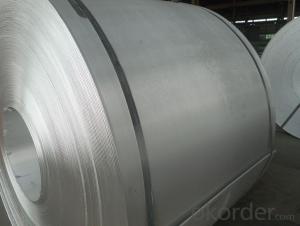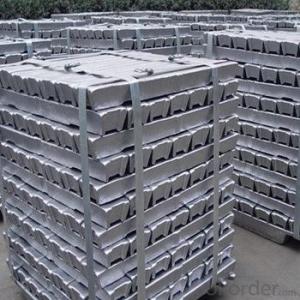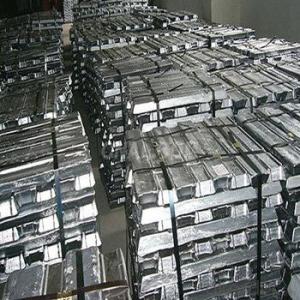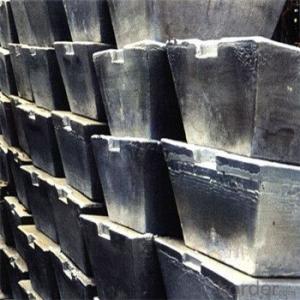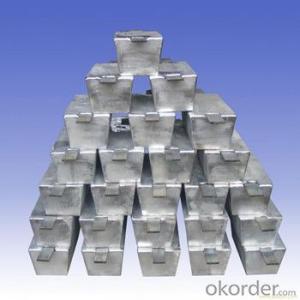Aluminum casting coil AA1070=P1020 for melt
- Loading Port:
- Tianjin
- Payment Terms:
- TT OR LC
- Min Order Qty:
- 200 m.t.
- Supply Capability:
- 5000 m.t./month
OKorder Service Pledge
OKorder Financial Service
You Might Also Like
Aluminium alloys (or aluminum alloys; see spelling differences) are alloys in which aluminium (Al) is the predominant metal. The typical alloying elements are copper, magnesium, manganese, silicon, tin and zinc. There are two principal classifications, namely casting alloys and wrought alloys, both of which are further subdivided into the categories heat-treatable and non-heat-treatable. About 85% of aluminium is used for wrought products, for example rolled plate, foils and extrusions. Cast aluminium alloys yield cost-effective products due to the low melting point, although they generally have lower tensile strengths than wrought alloys. The most important cast aluminium alloy system is Al–Si, where the high levels of silicon (4.0–13%) contribute to give good casting characteristics. Aluminium alloys are widely used in engineering structures and components where light weight or corrosion resistance is required
Specification:
Alloy: AA1070
Temper: F
Thickness:6mm—100mm
Width: 900mm—2300mm (Can be slitted)
Inner Diameter: 508MM
Coil Weight: AS REQUIRED
Application: MELT FOR LINGOTE TO MAKE ALUMINUM COIL O PLATE
Features:
1. Excellent quality of products
2. Quick delivery
3. Best service to clients
4. BV,SGS avalible
5. No buckle o waveness
6. Tension leveling
7. Certificate of Origin
8. Form A,E,F
Packaging Detail:
Carton ,Wooden pallet with plastic protection packing ,standard seaworthy packing or as your request.
Production Capacity:
Annual Production capacity of 600,000 tons.
Products are exported to United States, Canada, U.A.E, Brazil, Mexico,Thailand, Vietnam, Nigeria etc, over 100 countries and regions all over the world.
Production Line:
CNBM aluminum production base is comprised of 18 aluminum annealers, 10 coil and foil mills, 4 continuous production lines, 2 hot rolling production line and 3 prepainted lines.
FAQ:
1. What is the form of payment?
Normally 30% TT, 100% L
/C AT SIGHT
2. Type of quotation?
FOB, CFR, CIF
3. Port of loading?
Any port in China
4. Delivery time?
30 day after client’s deposit
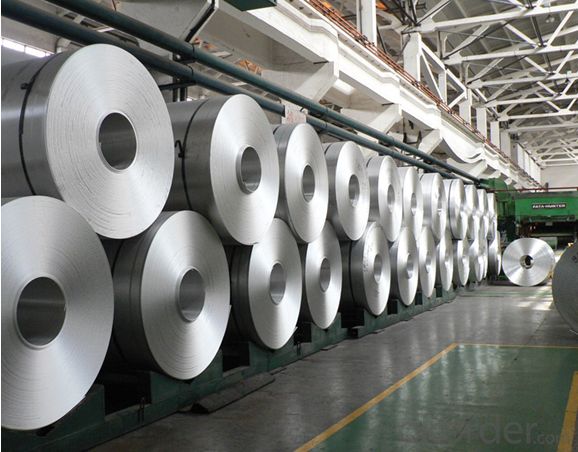
- Q:What are the advantages of using aluminum ingots in the production of renewable energy systems?
- Using aluminum ingots in the production of renewable energy systems offers several benefits. Firstly, aluminum's lightweight nature facilitates easy transportation and installation in various renewable energy systems such as solar panels and wind turbines. This characteristic also reduces the strain on supporting structures, resulting in cost savings for materials and installation. Secondly, aluminum possesses excellent corrosion resistance properties, which is crucial for renewable energy systems that often face harsh environmental conditions. This resistance ensures the systems' longevity and durability, reducing maintenance and replacement expenses. Moreover, aluminum is highly recyclable, allowing for repeated use without any degradation in quality. This recyclability makes aluminum a sustainable choice for renewable energy systems, aligning with the objective of minimizing environmental impact. Furthermore, aluminum boasts high thermal conductivity, enabling efficient dissipation of heat in renewable energy systems. This property is particularly advantageous in applications like solar panels, where excessive heat can hinder efficiency. By effectively dispersing heat, aluminum ensures optimal performance and prolongs the system's lifespan. Additionally, aluminum ingots are easily moldable and customizable into various shapes and sizes. This flexibility in design empowers manufacturers to create renewable energy systems with enhanced efficiency, optimizing performance and adapting to different project requirements. Lastly, compared to alternatives like steel or copper, aluminum is a cost-effective material. Its relatively low cost enables the more affordable production of renewable energy systems, making them accessible to a wider range of consumers. In conclusion, the use of aluminum ingots in the production of renewable energy systems offers advantages in terms of lightweight construction, corrosion resistance, recyclability, thermal conductivity, design flexibility, and cost-effectiveness. These qualities contribute to the overall efficiency, durability, and affordability of renewable energy systems, establishing aluminum as a preferred material in the industry.
- Q:Can aluminum ingots corrode?
- Yes, aluminum ingots can corrode. Although aluminum is known for its corrosion resistance, it is not completely immune to corrosion. When exposed to certain environments, such as salty or acidic conditions, aluminum can undergo a process called oxidation, which results in the formation of a thin layer of aluminum oxide on its surface. This layer acts as a protective barrier, preventing further corrosion. However, if this layer is damaged or compromised, the underlying aluminum can be exposed to corrosive elements, leading to corrosion. Therefore, while aluminum ingots are generally resistant to corrosion, proper care must be taken to protect them in corrosive environments.
- Q:What is the role of aluminum ingots in the production of aircraft engines?
- Aluminum ingots are of utmost importance when it comes to manufacturing aircraft engines. This lightweight metal possesses exceptional strength, high thermal conductivity, and excellent corrosion resistance, which makes it an ideal material for various components in aircraft engines. One major application of aluminum ingots in aircraft engines is the production of engine casings. These casings serve as protective housing for internal engine components like the combustion chamber, turbine, and compressor. Thanks to aluminum's lightweight nature, the overall weight of the engine can be reduced, resulting in improved fuel efficiency and enhanced aircraft performance. Moreover, aluminum ingots are utilized in the manufacturing of engine components such as pistons, cylinder heads, and connecting rods. These parts require a combination of strength, durability, and heat dissipation properties, all of which can be provided by aluminum. By incorporating aluminum ingots into these components, engine manufacturers can achieve a balance between weight reduction and ensuring structural integrity. Furthermore, heat exchangers and cooling systems within aircraft engines are fabricated using aluminum ingots. These systems play a crucial role in regulating the temperature of various engine parts, ensuring optimal performance and preventing overheating. Aluminum's high thermal conductivity allows for efficient heat transfer, making it an excellent choice for these applications. In addition to its material properties, aluminum ingots are favored for their ease of processing and manufacturing. Aluminum can be cast, forged, extruded, and machined into intricate shapes and designs, enabling the production of engine components with precise specifications. Overall, aluminum ingots play an indispensable role in the production of aircraft engines. Their lightweight nature, strength, thermal conductivity, corrosion resistance, and ease of processing make them the preferred material for manufacturing engine casings, components, and cooling systems. By incorporating aluminum ingots into aircraft engine production, the overall performance, efficiency, and reliability of modern aircraft are significantly enhanced.
- Q:Sincerely ask predecessors to tell me about the processing of aluminum ingots to doors and windows, curtain walls, aluminum profiles, the general process and about the process!
- Then, the aluminum bar is used as the material extruding machine, and then the die is extruded into the shaped section which needs to be shaped. After the cut of the section bar is cut off, the heat treatment is carried out to increase the strength. And then shot peening, oxidation, color, and become our doors and windows, curtain wall materials.
- Q:How do aluminum ingots contribute to the circular economy?
- Aluminum ingots play a significant role in contributing to the circular economy due to their recyclability and multiple applications. The circular economy is an economic system aimed at minimizing waste and maximizing the value of resources by promoting reuse, recycling, and remanufacturing. One key aspect of aluminum ingots is their recyclability. Aluminum is one of the most recycled materials globally, with a recycling rate of around 70-80%. This means that a large portion of aluminum used in various products can be recycled and transformed into new aluminum ingots. This recycling process requires significantly less energy compared to primary aluminum production, resulting in reduced greenhouse gas emissions and a lower environmental footprint. Moreover, aluminum ingots have numerous applications across various industries, including construction, automotive, aerospace, packaging, and electronics. By using recycled aluminum ingots, these industries can reduce their dependence on virgin (primary) aluminum extraction, which is an energy-intensive process. The use of recycled aluminum ingots not only conserves natural resources but also helps in reducing carbon emissions associated with primary aluminum production. Additionally, the circular economy approach encourages the design and production of products with recyclability in mind. Aluminum ingots can be easily melted down and reshaped into various forms, allowing for the creation of new products while maintaining their quality. This closed-loop system ensures that aluminum remains in circulation, reducing the need for raw material extraction and minimizing waste generation. In conclusion, aluminum ingots contribute to the circular economy by being highly recyclable, enabling the transformation of waste aluminum into valuable resources. Their use in various industries promotes sustainability, reduces energy consumption, and minimizes waste, making aluminum ingots an essential component in the transition to a more circular and resource-efficient economy.
- Q:How are aluminum ingots used in the production of electrical enclosures?
- Aluminum ingots are used in the production of electrical enclosures as they are melted down and cast into specific shapes and sizes to create the main body of the enclosure. The ingots provide the necessary raw material for the enclosure's construction, offering strength, durability, and corrosion resistance. Additionally, aluminum ingots can be easily formed, machined, and welded, allowing for the creation of intricate designs and precise dimensions required for electrical enclosures.
- Q:What are the main factors influencing the choice between aluminum ingots and aluminum wires?
- The main factors influencing the choice between aluminum ingots and aluminum wires are the intended use or application, cost considerations, and the manufacturing process.
- Q:How is aluminum ingot produced?
- Aluminum ingots are produced through a process called smelting, where alumina (aluminum oxide) is extracted from bauxite ore and then converted into molten aluminum. This molten aluminum is then poured into molds and cooled down to form solid ingots, which are later used as raw material in various industries.
- Q:How are aluminum ingots used in the production of sporting goods?
- Aluminum ingots are used in the production of sporting goods as they provide a lightweight yet durable material for various components like bike frames, golf club heads, tennis rackets, and baseball bats. The ingots are melted and then shaped into the desired form, allowing manufacturers to create high-performance and long-lasting sporting equipment.
- Q:What method does common smelting aluminium ingot adopt now?
- Due to coal and coke can precisely control the temperature, material loss is large, will not be considered; oil and natural gas are influenced by energy prices, the international economic recovery price will rise, the price is also expensive fuel now than power consumption, also not be considered;
1. Manufacturer Overview |
|
|---|---|
| Location | |
| Year Established | |
| Annual Output Value | |
| Main Markets | |
| Company Certifications | |
2. Manufacturer Certificates |
|
|---|---|
| a) Certification Name | |
| Range | |
| Reference | |
| Validity Period | |
3. Manufacturer Capability |
|
|---|---|
| a)Trade Capacity | |
| Nearest Port | |
| Export Percentage | |
| No.of Employees in Trade Department | |
| Language Spoken: | |
| b)Factory Information | |
| Factory Size: | |
| No. of Production Lines | |
| Contract Manufacturing | |
| Product Price Range | |
Send your message to us
Aluminum casting coil AA1070=P1020 for melt
- Loading Port:
- Tianjin
- Payment Terms:
- TT OR LC
- Min Order Qty:
- 200 m.t.
- Supply Capability:
- 5000 m.t./month
OKorder Service Pledge
OKorder Financial Service
Similar products
New products
Hot products
Related keywords

